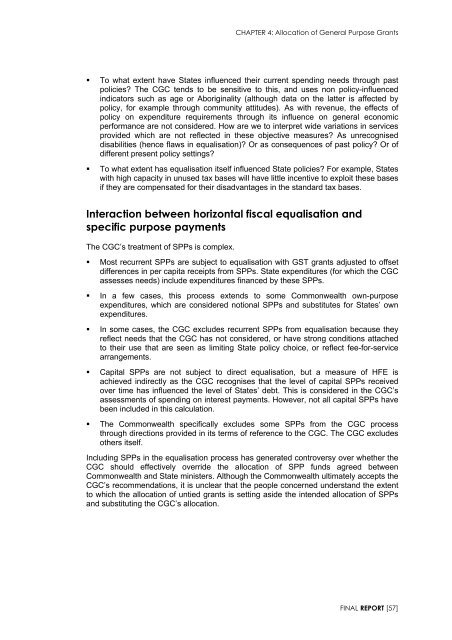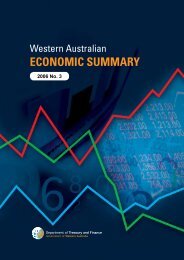Garnaut Fitzgerald Review of Commonwealth-State Funding
Garnaut Fitzgerald Review of Commonwealth-State Funding
Garnaut Fitzgerald Review of Commonwealth-State Funding
You also want an ePaper? Increase the reach of your titles
YUMPU automatically turns print PDFs into web optimized ePapers that Google loves.
CHAPTER 4: Allocation <strong>of</strong> General Purpose Grants<br />
• To what extent have <strong>State</strong>s influenced their current spending needs through past<br />
policies The CGC tends to be sensitive to this, and uses non policy-influenced<br />
indicators such as age or Aboriginality (although data on the latter is affected by<br />
policy, for example through community attitudes). As with revenue, the effects <strong>of</strong><br />
policy on expenditure requirements through its influence on general economic<br />
performance are not considered. How are we to interpret wide variations in services<br />
provided which are not reflected in these objective measures As unrecognised<br />
disabilities (hence flaws in equalisation) Or as consequences <strong>of</strong> past policy Or <strong>of</strong><br />
different present policy settings<br />
• To what extent has equalisation itself influenced <strong>State</strong> policies For example, <strong>State</strong>s<br />
with high capacity in unused tax bases will have little incentive to exploit these bases<br />
if they are compensated for their disadvantages in the standard tax bases.<br />
Interaction between horizontal fiscal equalisation and<br />
specific purpose payments<br />
The CGC’s treatment <strong>of</strong> SPPs is complex.<br />
• Most recurrent SPPs are subject to equalisation with GST grants adjusted to <strong>of</strong>fset<br />
differences in per capita receipts from SPPs. <strong>State</strong> expenditures (for which the CGC<br />
assesses needs) include expenditures financed by these SPPs.<br />
• In a few cases, this process extends to some <strong>Commonwealth</strong> own-purpose<br />
expenditures, which are considered notional SPPs and substitutes for <strong>State</strong>s’ own<br />
expenditures.<br />
• In some cases, the CGC excludes recurrent SPPs from equalisation because they<br />
reflect needs that the CGC has not considered, or have strong conditions attached<br />
to their use that are seen as limiting <strong>State</strong> policy choice, or reflect fee-for-service<br />
arrangements.<br />
• Capital SPPs are not subject to direct equalisation, but a measure <strong>of</strong> HFE is<br />
achieved indirectly as the CGC recognises that the level <strong>of</strong> capital SPPs received<br />
over time has influenced the level <strong>of</strong> <strong>State</strong>s’ debt. This is considered in the CGC’s<br />
assessments <strong>of</strong> spending on interest payments. However, not all capital SPPs have<br />
been included in this calculation.<br />
• The <strong>Commonwealth</strong> specifically excludes some SPPs from the CGC process<br />
through directions provided in its terms <strong>of</strong> reference to the CGC. The CGC excludes<br />
others itself.<br />
Including SPPs in the equalisation process has generated controversy over whether the<br />
CGC should effectively override the allocation <strong>of</strong> SPP funds agreed between<br />
<strong>Commonwealth</strong> and <strong>State</strong> ministers. Although the <strong>Commonwealth</strong> ultimately accepts the<br />
CGC’s recommendations, it is unclear that the people concerned understand the extent<br />
to which the allocation <strong>of</strong> untied grants is setting aside the intended allocation <strong>of</strong> SPPs<br />
and substituting the CGC’s allocation.<br />
FINAL REPORT [57]

















